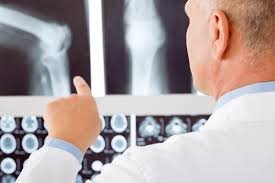Total knee replacement is a surgery performed to replace the diseased knee joint with the artificial material. The knee is a vital joint that offers motion where the thigh meets the lower leg. Depending on the condition of the kneecap portion of the patient’s knee joint, a plastic button may also be added under the kneecap surface. The artificial parts of a total knee replacement are termed as the prosthesis.
Who are the candidates for total knee replacement?
Candidates of Total knee replacement surgery are patients whose knee joints have been damaged due to progressive arthritis, trauma, or else many other rare destructive diseases linked with a joint. The most common cause for knee replacement is severe osteoarthritis of the knees. Irrespective of the game if the knee joint is damaged, it will result in severe pain as well as stiffness.
The risk involved in total knee replacement surgery
There are many risks involved in total knee replacement surgery counting
- Blood clots in legs
- Shortness of breath due to Pulmonary embolism
- Chest pain
- Shock
- Urinary tract infection
- Vomiting
- Nausea
- bleeding into the knee joint
- nerve damage
- blood vessel injury
- infection of the knee
The procedure of total knee replacement
Below we have listed step by step procedure of total knee replacement surgery
- The surgeon will make an incision to gain access to the patella, also referred to as the kneecap.
- When the knee is open, the surgeon will rotate the patella as it will allow the surgeon to view the area where he/she has to do the surgical procedure.
- Once the surgeon exposes your knee joint, he or she will measure your bones and make precise cuts.
- The surgeon attaches the metal femoral component at the end of your femur and utilizes bone cement to seal it.
- The next bone, your surgeon, resurfaces, is the shinbone. The tibial tray is fitted to the tibia and will be secured into place by using bone cement.
- After that, the surgeon will flatten the patella and fit it with an additional plastic component to ensure a proper fit with the rest of your implant.
- Following this surgeon will bend and flex the knee to guarantee that the implant is working correctly. He/she will also check alignment, sizing, as well as positioning, is suitable.
- To end the process the surgeon will close the incision with stitches or staples. After that, he/she will bandage it.
What to expect before and after total knee replacement surgery?
Before
Before the surgery doctor will evaluate the condition of joints adjacent to diseased knee to ensure optimal outcome and recovery after total knee replacement.also all medications that the patient is taking are reviewed. After that, medications may have to be adjusted or discontinued by a doctor before knee replacement surgery. Doctors also recommend many blood tests of liver and kidney along with urine tests to evaluate the symptoms of infection, anemia or else abnormal metabolism. They will also recommend chest XRay and EKG to determine heart and lung disease.
After
Knee replacement surgery cost in India ranges from USD 4000 to USD 6000 for Single Knee and from USD 8400 to USD 12000 for both knees. After one and a half to three hours of successful knee replacement surgery patients are taken to a recovery room, to monitor all vital organs. However, the passage of urine can be difficult in the immediate postoperative period. Physical therapy is an important part of rehabilitation, and that requires full participation by the patient to get the best results. Patients are also suggested to start physical therapy just 48 hours after surgery. It is normal to experience some degree of pain, discomfort, as well as stiffness during the initial days of physical therapy. Doctors also suggest using knee immobilizers to stabilize the knee while undergoing physical therapy, walking, sleeping and more. A device known as a CPM machine is used to help patients with speed recovery. This CPM machine is initially attached to the operated leg. And after that machine continually moves the knee through many degrees of range of motion for hours and helps patients to get relaxed. With the help of this machine, patients improve their circulation and also minimize the risk of contracture of the tissues around the knee.





